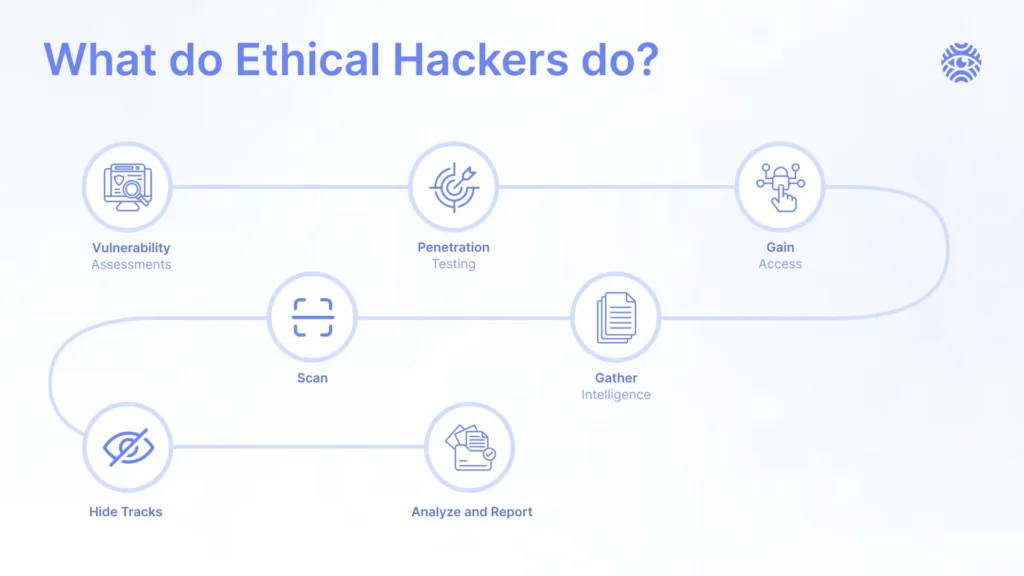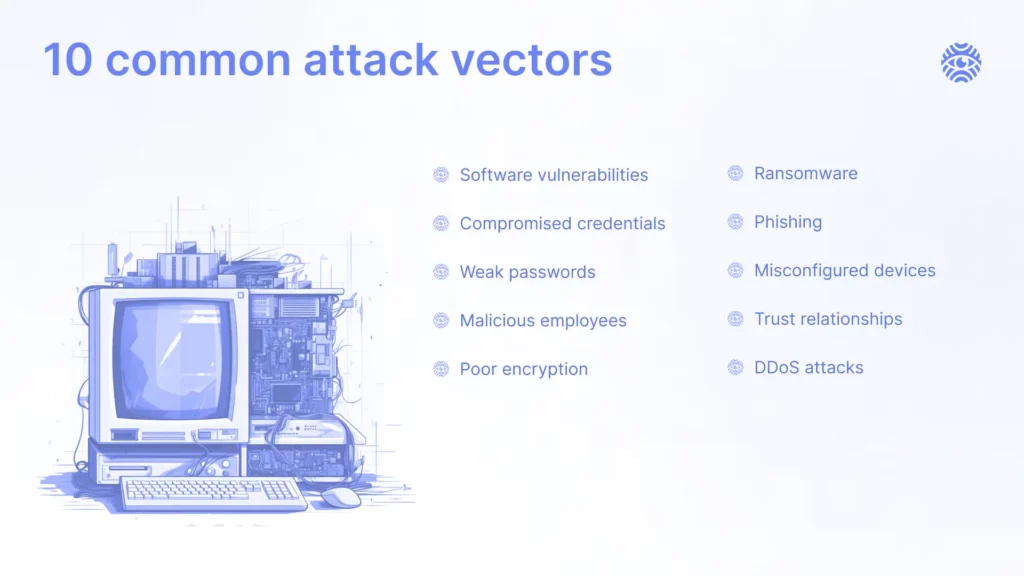

The general rule of thumb is that OSINT is not about hacking and other intrusive investigation methods. In most cases, open source intelligence is enough to unveil valuable information. However, in some instances, these two practices can intertwine for in-depth research of a person or a system’s health check. For example, knowing how hackers think and act is essential to secure the network and find vulnerable places in the cyber defense. Want to learn how to boost your hacker skills? Consult this guide about entry-level system breaching and social engineering you can master.
Always Distinguish Open Source Intelligence (OSINT) and Hacking
The first step to honing the knowledge of both hacking and OSINT is to make sure you never confuse the two. OSINT refers to the process of assembling and analyzing insights from publicly available sources, while hacking involves gaining unauthorized access to digital systems or data with the intention of exploiting vulnerabilities in one way or another.
Even though hacker activities are often malicious, ethical hacking is an exception, where individuals with proper authorization test systems for weak points to improve security. In these instances, hacking and OSINT go hand in hand. Consider the following scenarios when hacking is helpful for the organization:
When Is It Allowed to Use Hacking in OSINT?

- Testing the Defense of the Organization. The company can use the elements of hacking to check out whether the security system can withstand actual penetration by the culprit.
- Protecting Critical Infrastructure. Governmental agencies often need the assistance of ethical hackers to make sure that outside forces will not be able to access assets important to national security.
- Learning From the Culprits. For OSINT pros, it is essential to stay ahead of the curve and be aware of the latest system manipulation methods. As a result, experts will be ready to stand against malicious penetrators in case they attack in the real field.
Some Essential Hacker Skills for You

As with any other digital profession, pro-level hacking requires a lot of knowledge and experience. However, anyone can nail the basics of OSINT hacks using publicly available resources. Here are the things you can and should know when it comes to the fundamentals of hacking:
Master Social Engineering
One underestimated part of hacking is the people skills needed to get the desired information using social engineering. This technique is used by hackers to trick people into revealing confidential information or allowing culprits to enter the system. You should know these social engineering principles to identify hackers and prepare the organization’s employees for the potential risks:
Use OSINT Skills to Do Checks With X-Ray Contact
As a data aggregator, X-Ray Contact is effective for getting a Search Profile on an individual. The software has five entry channels: Socials, Image, Phone Number, Name and Email Address. If you know at least one of these cues, insert them in a search bar and receive an overview of all the details that may be available in the database. This information will help you learn more about the hackers or check whether a legitimate, reliable person gains access to the system.

Stay Aware of Phishing
Social engineering through phishing involves sending deceptive emails, messages or websites that appear to be from a trusted source. The goal is to trick individuals into revealing sensitive information like login credentials, credit card numbers or personal details. The culprits pray on unattentiveness and failure to follow security protocols. That’s why employees should be aware of how to tell apart a legitimate source from a fake one to prevent worst-case outcomes.
Know How Hackers Can Lure You With Baiting
Baiting involves offering something enticing, such as a free software download or a document that has a tempting name, with the intent of infecting the target’s system or gaining access to it. For example, an employee can receive an email with a promotion list file they need to download in order to see the data. Once the user opens the file, it may seem to work normally. However, in the background, the malicious software could be installing malware, keyloggers, or other hacking tools on the user’s system without their knowledge. You should prepare the team to stay vigilant, no matter how alluring or curious the bait is.
Do Not Be Fooled By Pretexting
Pretexting is a social engineering strategy where an attacker creates a fake scenario or believable reasoning to trick individuals into giving in sensitive information or performing actions they wouldn’t otherwise do. It involves gaining the trust of the target by pretending to be someone they know, especially a person in authority. That’s why the organization should have a well-tuned communication system to prevent penetration with social engineering practices.
One common scenario is when an attacker calls a target posing as a tech support specialist from their company. To add urgency and pressure, the culprit persuades that immediate action is required to prevent data loss, system damage or a potential security breach. They insist on remote access to the target’s computer to resolve the supposed issue. Once the attacker gains control or acquires sensitive information, they may install malware, steal personal data or commit financial fraud, while the victim may remain unaware of the scam until it’s too late.
Learn to Detect Scareware
Another approach hackers use in social engineering is making sure that the victim feels scared and fearful. Scareware is another type of social engineering technique. It uses deceitful tactics to manipulate users into thinking their computer is infected with the virus. The goal is to create fear or panic in the user, which motivates them to follow the scenario desired by the hacker. That’s why organizations should have protocols and security training based on common hacking practices.
Try Out Google Dorking
Even search engines such as Google can be a great starting point for hacking OSINT. For instance, Google Dorking refers to the use of advanced search techniques on the service to locate specific information on the Internet. With these instruments, you can find security gaps and vulnerabilities that allow you to penetrate the system. Check out some of the most useful dork queries you can use for hacking:
- Exploit the “site” query to find a specific word mentioned on the website. For example, a “sensitive” word search request to find out whether any restricted information is exposed.
- Use “filetype” to look for different kinds of publications that can reveal in-depth info, such as PDF reports or Word documents.
- Both queries, “inurl” and “intitle,” help to narrow down the number of sites analyzed upon request based on a keyword in a URL name or a title, respectively.
- “Intext” requests can be useful for processing a long text in order to find a specific keyphrase. For instance, it analyzes site pages to locate the mentions of IDs or passwords.
- Utilize “cache” to retrieve the last saved version of the website, even if it is currently down and unavailable.
Analyze Leaks and Breaches
Delve into the hacking experiences of the other organizations to be prepared in case the danger strikes. This includes details from official statements by the affected organization, breach reports from cybersecurity firms and any public disclosures. That’s how you can determine common attack vectors, such as phishing, exploiting vulnerabilities, or using malware. Leverage such instruments to know more about leaks and breaches:
- BitSight software is a comprehensive tool for finding leaked data on the dark web. This cybersecurity instrument can help to spot current weaknesses and the potential risks for both the organizations and third parties.
- X-Ways Forensics is a program used to analyze and recover data from various storage media and computer systems. X-Ways Forensics provides advanced search and filtering capabilities, enabling investigators to search for specific keywords, patterns, or file attributes. It can even spot deleted files that the site owner tries to hide.
- Volatility is an efficient tool for analyzing memory dumps that can be useful for both hacking and OSINT. It helps in extracting information about running processes, network connections, and other system activities. Volatility is commonly used in incident response investigations to identify signs of malicious activity, understand the behavior of malware and uncover artifacts related to security incidents.
Leverage Virtualization

New tech allows having advanced mechanisms for checking the security system in a perfect environment. Virtualization is used in ethical hacking and penetration testing for creating isolated networks to simulate real-world systems. Tools like VMware and VirtualBox allow security professionals to test vulnerabilities, exploits, and security measures in a controlled space.
Virtual machines are employed in malware analysis to study and understand the behavior of malicious software without any risk to the system. In this case, cybersecurity teams master both hacking and OSINT to prevent a real-life system crash that follows a similar scenario.
Get Linux Proficiency
In itself, Kali Linux is an open-source service designed for penetration testing and ethical hacking to test the security of the systems. Kali Linux finds loopholes in the cyber defense system with the help of tools for information collection, vulnerability analysis as well as wireless and password attacks. For example, here are some internal instruments of Kali Linux you can leverage:
- Nmap. Use it to scan a network for open ports, single out active hosts, and find out about the services running on those ports.
- Metasploit. Activate it to test known exploits against vulnerable systems, gaining remote access to specific tech devices for assessing the impact of potential security flaws.
- Aircrack-ng. Employ the tool to capture and analyze network traffic, test for vulnerabilities and crack Wi-Fi passwords.
- John the Ripper. Utilize it to perform offline password cracking and test the strength of user passwords.
- OpenVAS. Run it to identify vulnerabilities in the networks, such as outdated software versions or misconfigurations.
Add in OSINT Hacks
Linux has tools not only for hacking but for OSINT purposes as well. Utilize tools like Recon-ng and theHarvester to gather information from social media platforms, public databases, and other online sources to build a profile of the target. Use Maltego in Kali Linux to perform domain reconnaissance as well as expose relationships between assets. Take advantage of LocationIQ for geolocation data based on IP addresses and use Shodan to search for devices connected to the Internet network.
Do Not Waste Time on Useless Websites Hacker Skills
The array of hacking techniques and software available in one click is vast. The crucial task is to separate what you really need to strengthen the company’s digital defense and what is excessive. Remember the following rules:
- Don’t Waste Assets and Efforts. If resources are tight, identify and prioritize critical assets within the organization. Concentrate efforts on securing systems and data that are most valuable and sensitive.
- Prioritize Based on Risk. Do a thorough risk assessment to understand potential vulnerabilities and threats. Think first about addressing high-risk areas that could have severe consequences if exploited and what skills are necessary for this goal.
- Keep Things Up to Date. Skills in programming languages and software that have fallen out of widespread use are not in demand for contemporary ethical hacking. Match your proficiency based on new threats that arise.
Conclusion: Be Sure to Pursue New Hacker Skills That Everyone Should Learn
The sole idea of combining OSINT and hacking might seem intimidating as they are often used on two rivaling sides of cyber defense. Nonetheless, ethical hacking has an immense potential for bringing the digital security of the firm to the next level. Combining OSINT and ethical hacking allows for a more holistic approach to cybersecurity. OSINT provides valuable context and information about potential attack vectors, while ethical hacking enables proactive testing and strengthening of defenses. That’s how you will never be caught off guard in case a real culprit attempts to penetrate the network.


